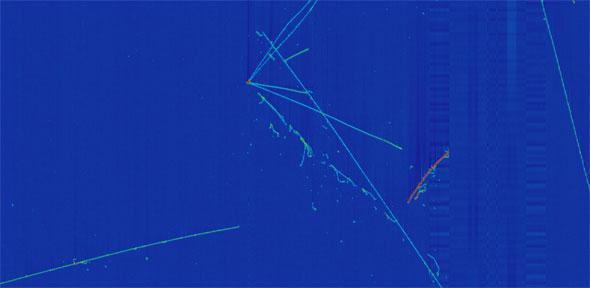
This week, UK Universities and Science Minister Jo Johnson signed the agreement with the US Energy Department to invest the sum in the Long-Baseline Neutrino Facility (LBNF) and the Deep Underground Neutrino Experiment (DUNE). DUNE will study the properties of mysterious particles called neutrinos, which could help explain more about how the universe works and why matter exists at all.
This latest investment is part of a long history of UK research collaboration with the US, and is the first major project of the wider UK-US Science and Technology agreement.
On signing the agreement in Washington DC, UK Science Minister, Jo Johnson said: “Our continued collaboration with the US on science and innovation is beneficial to both of our nations and through this agreement we are sharing expertise to enhance our understanding of many important topics that have the potential to be world changing.
“The UK is known as a nation of science and technical progress, with research and development being at the core of our industrial strategy. By working with our key allies, we are maintaining our position as a global leader in research for years to come.”
“The international DUNE collaboration came together to realise a dream of a game-changing program of neutrino science; today’s announcement represents a major milestone in turning this dream into reality,” said Professor Thomson. “This UK investment in fundamental science will enable us to deliver critical systems to the DUNE experiment and to provide new opportunities for the next generation of scientists to work at the forefront of science and technology.”
This investment is a significant step which will secure future access for UK scientists to the international DUNE experiment. Investing in the next generation of detectors, like DUNE, helps the UK to maintain its world-leading position in science research and continue to develop skills in new cutting-edge technologies.
The UK’s Science and Technology Facilities Council (STFC) will manage the UK’s investment in the international facility, giving UK scientists and engineers the chance to take a leading role in the management and development of the DUNE far detector and the LBNF beam line and associated PIP-II accelerator development.
Accompanying Jo Johnson on the visit to the US, Chief Executive Designate at UK Research and Innovation, Sir Mark Walport said: “Research and innovation are global endeavours. Agreements like the one signed today by the United Kingdom and the United States set the framework for the great discoveries of the future, whether that be furthering our understanding of neutrinos or improving the accessibility of museum collections.
“Agreements like this also send a clear signal that UK researchers are outward looking and ready to work with the best talent wherever that may be. UK Research and Innovation is looking forward to extending partnerships in science and innovation around the world.”
DUNE will be the first large-scale US-hosted experiment run as a truly international project at the inter-governmental level, with more than 1,000 scientists and engineers from 31 countries building and operating the facility, including many from the UK. The US is meeting the major civil construction costs for conventional facilities, but is seeking international partners to design and build major elements of the accelerator and detectors. The total international partner contributions to the entire project are expected to be about $500M.
The UK research community is already a major contributor to the DUNE collaboration, with 14 UK universities and two STFC laboratories providing essential expertise and components to the experiment and facility. This ranges from the high-power neutrino production target, the readout planes and data acquisitions systems to the reconstruction software.
Dr Brian Bowsher, Chief Executive of STFC, said:“This investment is a significant and exciting step for the UK that builds on UK expertise.
“International partnerships are the key to building these world-leading experiments, and the UK’s continued collaboration with the US, through STFC, demonstrates that we are the science partner of choice in such agreements.
“I am looking forward to seeing our scientists work with our colleagues in the US in developing this experiment and the exciting science which will happen as a result.”
One aspect DUNE scientists will look for is the differences in behaviour between neutrinos and their antimatter counterparts, antineutrinos, which could give us clues as to why we live in a matter-dominated universe – in other words, why we are all here, instead of having been annihilated just after the Big Bang. DUNE will also watch for neutrinos produced when a star explodes, which could reveal the formation of neutron stars and black holes, and will investigate whether protons live forever or eventually decay, bringing us closer to fulfilling Einstein’s dream of a grand unified theory.
The DUNE experiment will attract students and young scientists from around the world, helping to foster the next generation of leaders in the field and to maintain the highly skilled scientific workforce worldwide.
The Cambridge team is playing a leading role in the development of the advanced pattern recognition and computational techniques that will be needed to interpret the data from the vast DUNE detectors.
Other than Cambridge, the UK universities involved in the project are Birmingham, Bristol, Durham, Edinburgh, Imperial, Lancaster, Liverpool, UCL, Manchester, Oxford, Sheffield, Sussex and Warwick.
Adapted from an STFC press release.
The UK is investing £65 million in a flagship global science project based in the United States that could change our understanding of the universe, securing the UK’s position as the international research partner of choice. Professor Mark Thomson from the University of Cambridge’s Cavendish Laboratory has been the elected co-leader of the international DUNE collaboration since its inception and is the overall scientific lead of this new UK initiative.

The text in this work is licensed under a Creative Commons Attribution 4.0 International License. For image use please see separate credits above.